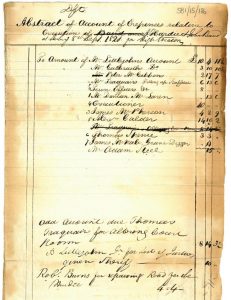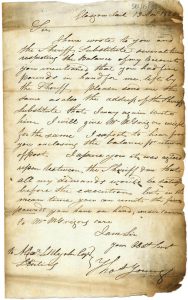September’s Document of the Month commemorates the sacrifice made by two of the men who were involved in what we now call the Radical Uprising of 1820. John Baird and Andrew Hardie were executed on the 8th September of that year in Stirling, and died bravely, never recanting the beliefs that had seen them take up arms against injustice.
You can read more about the Uprising itself and the organisation of the execution in Stirling in our series of blog posts commemorating these events on this their 200th anniversary here.
There is a small bundle of documents held at the Archives of letters and accounts relating to the arrangements made for the execution of two men who many at the time believed died as martyrs in the cause of freedom. The Burgh Town Clerk’s Office under the Clerks Alexander Littlejohn and William Galbraith were given the task of organising the execution, which was to happen at Stirling Castle on the 8th of September. The documents, with their matter of fact discussion of the technicalities of the sentence of hanging and then decapitation, make for particularly gruesome reading.
Andrew Hardie and John Baird were tried in Glasgow on the 4th August. At the trial the Judge advised “To you Andrew Hardie and John Baird I can hold out little or no hope of mercy… as you were the leaders, I am afraid that example must be given by you.” They were accordingly sentenced to death for their views and beliefs, betrayed by the establishment that they had sought to reform. The rest of the rebels were sentenced to be transported overseas to penal colonies in New South Wales and Tasmania, including the James Clelland who is mentioned in the death warrant.
Public execution in Stirling was usually handled by the Hangman or Staffman as he was known. This official had his own acre at Braehead and a house on St John’s Street. Previously, in the 17th century, executions had taken place at the Mailing Gallows where the Black Boy Fountain now stands. On this occasion however, such was the public feeling for the two condemned men that officials were brought in secret from Glasgow to Stirling to undertake their grisly work. Two men were required, one hangman and one decapitator. The hangman was one Thomas Young from Glasgow, the decapitator, an unnamed medical student from Edinburgh. Both were brought to Stirling by night in conditions of the greatest secrecy to ensure that they were not discovered and attacked by local people. Support for the two condemned men locally was high.
The letters give details of the need for secrecy:
“The man [the Decapitator] wishes of all things to be kept private so that it must be gone about as quietly as possible, so that nobody may know when he comes and goes…” Galbraith to Littlejohn 2nd September 1820
“Meantime as the Person [the Hangman]… wishes to remain incog. and to be conducted from here by a confidential person who will be able to land him secretly at some place of secrecy & security which you can fix on and point out…” George Salmond to Littlejohn 2nd September 1820
Baird and Hardie were executed on the 8th September at Stirling, a crowd of 2,000 people were in attendance. Brave to the last, both men gave short speeches on the scaffold, Baird ended his speech “Although this day we die an ignominious death by unjust laws our blood, which in a very few minutes shall flow on this scaffold, will cry to heaven for vengeance, and may it be the means of our afflicted Countrymen’s speedy redemption.” Hardie then spoke of “our blood, shed on this scaffold… for no other sin but seeking the legitimate rights of our ill-used and down trodden beloved Countrymen”, then when the Sheriff angrily intervened he concluded by asking those present to “go quietly home and read your Bibles, and remember the fate of Hardie and Baird.” They were then hanged and after a while on the scaffold, cut down to be beheaded by the decapitator.
Both officials were gowned and masked so that their identity could not be seen by the crowd. The robe worn and axe used by the decapitator can be seen in The Smith Museum and Art Gallery today.
The last letter in the bundle is from Thomas Young, the Hangman and is dated 13th November 1820. In it he complains that he has still not been paid in full for his work. As may be seen from the account of the expenses of the execution, presented by the Town Clerk of Stirling to the Treasurer for payment, his was the highest fee at £40.
Thomas Young in Glasgow to Alexander Littlejohn, 13th November 1820.
Glasgow Jail 13 Nov 1820
Sir
I have wrote to you and the Sheriff Substitute several times respecting the balance of my Accounts you mentioned that you had five pounds in hand for me left by the Sheriff please send me the same as also the address of the Sheriff Substitute that I may again write to him I will give Mr McGrigor receipt for the same I expect to hear from you enclosing the balance per return of post I assure you it was agreed upon between the Sheriff & me that all my demands would be satisfied before the execution but in the mean time you can remits the five pounds you have on hand, under cover to Mr McGrigor’s care.
I am sir
your obedient servant
Thos Young
To Alexander Littlejohn Esq
Stirling.

